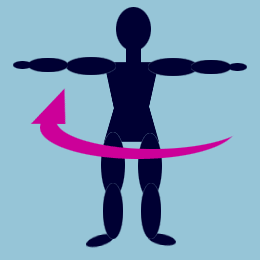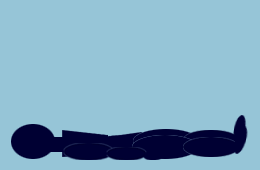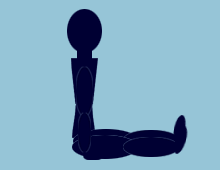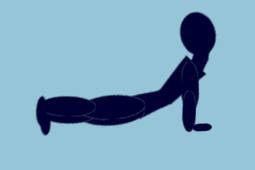These Powerful Mind–Body Exercises will Give Your Body Healing it Deserves and Slow Down Aging
These Powerful Mind–Body Exercises will Give Your Body Healing it Deserves and Slow Down Aging
Chris Kilham once did a segment with Doctor Oz on the Five Tibetan exercises. He wrote .
Chris Kilham is a well-known “medicine hunter, author, educator, and world-traveler researching and promoting plant-based medicines.
Kilham his audience that a daily five minute practice of the Five Tibetans will result in adding an entire decade to your life span. The exercises are done repetitiously on a gradient. The beginner starts out doing 1 to 5 repetitions for each exercise. It’s advisable to always listen to your body in order to avoid injury and never ever force your body to continue the exercises if your body is signaling pain.
Some soreness and minor discomfort is expected but beyond that is a danger zone that can lead to injury. The goal is to work up to twenty or some say 21 repetitions of each exercise at a comfortable pace.
The advised best times to practice are sunrise or sunset but anytime is better than never. Be sure to use a carpeted area, yoga mat, towel or throw rug to ease the discomfort of the body moving against a hard surface.
The room should be well ventilated. Choose a quiet area where you are not distracted by others and can easily concentrate. A video demonstration by Chris Kilham is presented at the bottom of this article.
How do I begin to benefit from the 5 Tibetans?
If you are not used to exercise or have not been formally introduced to yoga techniques of breathing and relaxation, then your first tip is to start out slowly. Start by performing one to three repetitions of each of the movements one time each day. Pay attention to what your body is telling you and do not strain or force any position that causes pain that indicates possible injury. A little soreness is perfectly okay but really you should start out slow enough not to have any physical hindrances the following day.
Where should I perform the Tibetans?
Anywhere you have room is perfectly okay. Make sure to use a carpet, towel, yoga mat or padding to prevent discomfort caused from too hard a surface.
What is the best time of day to perform the 5 Tibetan?
The entire series of movements may be performed 2 to 3 times per day. As with all forms of holistic body work, sunrise and sunset are great times to be honoring your body with physical work. These are the best times to start your practice, but you may work them into your schedule as you see fit.
How many time should I repeat each exercise?
You want to work toward performing each of the movements 21 times. When you first begin, try to do 1 or 3 repetitions of each exercise. After a week, try to do 3 repetitions, then pause and try 3 more. You will certainly feel stronger in some of the movements than others. If you have trouble performing a complete set of 21, try to break it down into 3 sets of 7 repetitions with a pause between each set. Once you’ve achieved 21 repetitions of each exercise, you don’t need to go on to more repetitions. These exercises are for restoring energy, not necessarily building strength. If you feel great after doing 21 repetitions of each movement, feel free to add another session later in the day to perform another set of 21 repetitions each.
What is the recommend breathing pattern?
We recommend a specific breathing pattern to follow with each exercise. If you feel tired or light headed while performing these movements, make sure you are not holding your breath.
Tibetan Rejuvenation Exercise Movement #1
Sufi Whirling, Whirling Dervish, Memories of the Grateful Dead in Concert, Having fun like a 3 year old

Rite 1: Stand upright, extend your arms at shoulder level away from your body and spin clockwise (if looking at a clock face on the floor). Keep your eyes looking directly in front of you, do not focus on any one point, let your vision blur as you spin. Turn up to 21 times or until you feel unstable or dizzy.
Breathing: breath in and out of your stomach. An opera singer, stage actor/actress or yogi experiences the benefit of breathing from this point of the body. When you stop spinning, breath even more deeply from your stomach until your head stops spinning and your balance returns to normal.
Tips and Recommendations: Work your way up to 21 spins. Speed is not so important, just try to spin 21 times and stop.
Tibetan Rejuvenation Exercise Movement #2
Leg Raises, Bending at the Waist, Tummy Tucks

Rite 2: Lay down on your back with your arms to your side, palms up, keep your legs straight, begin your inhalation, raise your legs off the ground until as high as possible and pick your head off the ground, bending your neck with your chin falling toward your chest. Begin your exhalation and return to laying flat on the ground. Repeat up to 21 times.
Breath In: Raising your legs and head
Breath Out: Lowering your legs and head
Tips and Recommendations: When starting out, bend your legs until your stomach strengthens. If your feel discomfort, place your hands (palms facing down) under your buttocks to support your lower spine. As you progress, straighten your legs and try to raise and lower them at the same speed. Once you have worked up to 21 repetitions, try to move at a nice steady rhythm without stopping.
Tibetan Rejuvenation Exercise Movement #3
Morning Neck Warm-up, Hotel Pillow Recovery Posture, Camel Asana in Yoga

Rite 3: Kneel with your legs together, arms extended, palms of your hands on the side of your thighs, drop your chin to your chest, begin your inhalation, raise your head and lean back, move your hands to the back of your thighs and let them drop lower and support your weight, crane your head and neck backward, relax your lower spine. Begin your exhalation, start to come forward back to kneeling position with your head back up in the straight position. Repeat up to 21 times.
Breath In: Going backward
Breath Out: Coming forward
Tips and Recommendations: When you start this exercise, use the weight of your head to come forward instead of forcing your chin to your chest with your muscles. When you lean back, avoid craning your neck, simply let it drop with its own weight. Eventually, you can bring your shoulder blades towards each other when you’re in the back position. Keep a steady movement while going backward and forward. Keep your eyes open to maintain balance. Later, try the movement with your eyes closed to feel the difference and see if you can relax even more in the backward position.
Tibetan Rejuvenation Exercise Movement #4
Table Posture, Wrist warm-up and Neck agility

Rite 4: Sit on the floor, legs a little less than shoulder width apart, arms to your sides with hands extended flat on the ground and fingers pointed forward, drop your head toward your chest, begin your inhalation, raise your buttocks off the ground while bending your knees, shift your weight to your arms/hands and legs/feet, continue to raise your buttocks until your trunck and thighs are parallel to the ground, let your head fall back. Begin your exhalation and return to sitting position with your head dropped forward. Repeat up to 21 times.
Breath In: Raising off the ground
Breath Out: Returning back to sitting position
Tips and Recommendations: When you begin this exercise, just try to get from the starting to ending posture. It’s easier to do it than read about it. In the beginning, you might not be used to your body weight on your wrists. Doing some wrist warm-ups before you begin can prevent discomfort. Once you have worked your way up to 21 repetitions, try to perform the movements without stopping.
Tibetan Rejuvenation Exercise Movement #5
Inverted-V, Yoga Cobra to Downward Dog

Rite 5: Get down on the floor on your hands and knees (in push-up position) with hands and legs a little less than shoulder width apart. Begin your inhalation, come up on your toes with weight in your arms, straighten your legs, arch your back, lean your head back, do not let any of your body touch the ground except for your toes and hands (Cobra in Yoga). Begin your exhalation, bend at the waist, bend your knees, push your buttocks up into the air, make an inverted V shape with your legs and arms straight, tuck your chin toward your chest (Downward Dog in Yoga), try to put your feet flat on the ground. Begin your next inhalation and repeat up to 21 times.
Breath In: Raising hips up into an ^ shape - downward dog.
Breath Out: Hips down & head coming up into cobra.
Tips and Recommendations: In the beginning, you will need to find where to place your hands and feet to make a complete inverted-V shape. You may do this exercise for years and never get your feet flat on the ground (a symptom of western living and always sitting in a chair). Once you’ve worked your way up to 21 repetitions, work on keeping a steady rhythm while going in and out of each position.
History
According to legend, the Five Tibetans originated form Tibetan Llamas around 2,500 years ago.
Anti-aging expert Ellen Wood, stresses the importance of doing the 5 Tibetans very slowly for maximum longevity results. The exercises were a secret practice handed down from generation to generation to a select few –the initiated.
The Tibetan monasteries guarded the practices as they were considered as part of a pathway to higher levels of consciousness. But a noted side-effect of the exercises was increased longevity and the restoration of youthfulness. This is what Chris Kilham is promoting.
Esoteric Benefits
Physical Health Benefits
These exercises, like Qi-gong or Chi-Gong, restore energy, unlike calisthenics which expend energy without restoration.They enhance overall strength, balance, energy, metabolism, digestion, brain and nervous system, cardiovascular and pulmonary systems and overall health.
Be the first to post a message!
